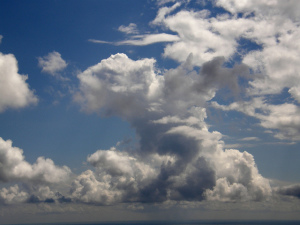The atmosphere is unpredictable. There is no avoiding the fact that no matter how many observations we make, and no matter how good our models are, we will never be able to say with complete confidence exactly how the weather and climate will behave at an exact future place and time. There is simply too much chaos in the system. Don’t be fooled by the weather forecast: the weatherman doesn’t know what’s going to happen, only what’s likely to happen. We can only talk about the chances of raining tomorrow, or the likelihood that the UK will experience more floods in twenty years’ time. In order to place confidence in our models, we need to assess how accurate these likelihoods are, as well as improving the models themselves.
The most important step forward in this regard in recent years was the development of ‘ensemble’ predictions. Here, many different models are run with subtly different initial conditions. In a weather forecast, these differences represent the uncertainty in our current weather observations. In a climate forecast, they may represent our uncertainty in how each type of ‘forcing’ on the atmosphere – such as solar radiation, greenhouse gasses, ocean heat transfer and particles released by living beings – will change the future climate in each region of the globe. Different runs of different models will produce different predictions, and the likelihood we can ascribe to a given event – be it rain over Oxford next Wednesday or droughts in the Amazon in 2030 – depends on the percentage of models that agree on that outcome.
Our models’ greatest weakness lies in the resolution that they’re able to work down to. To predict climate and weather on smaller scales, though, requires two innovations. First, we’re going to need to either increase our computing power significantly or use our current power more efficiently. This might be done by reducing the precision of the models’ inputs on very large scales so that there’s more computer crunch left over for smaller-scale effects. Secondly, we need to understand better how the climate works on small scales. A lot of the spread between current climate models – and hence their uncertainty – comes down to how they treat the formation and evolution of clouds in particular. At the moment, we treat large of chunks of cloud as uniform, when we know that in truth there is much more detailed, beautiful cloud structure within these rigid blocks that might affect how they evolve. More observations are needed to determine exactly how conditions on the ground warm moist packets of air that move upwards through convection because the atmosphere’s temperature falls with height more rapidly than theirs. A better analysis is needed to move beyond basic, idealised models about how this moisture condenses around aerosols, forming the clouds. Only if detailed observations are used to create more advanced models will we move closer towards the goal of understanding the atmosphere. And as an added bonus, we might just be able to predict its behaviour better too.
![Improving Forecasts The atmosphere is unpredictable. There is no avoiding the fact that no matter how many observations we make, and no matter how good our models […]](/wp-content/uploads/2014/03/Science-in-Society-Blog-final-draft-640x361.jpg)
